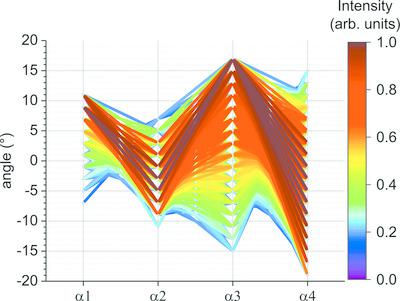当前位置:
X-MOL 学术
›
J. Appl. Crystallogr.
›
论文详情
Our official English website, www.x-mol.net, welcomes your
feedback! (Note: you will need to create a separate account there.)
A high-throughput assembly of beam-shaping channel-cut monochromators for laboratory high-resolution X-ray diffraction and small-angle X-ray scattering experiments
Journal of Applied Crystallography ( IF 5.2 ) Pub Date : 2021-04-16 , DOI: 10.1107/s1600576721002338 Peter Nadazdy , Jakub Hagara , Petr Mikulik , Zdenko Zaprazny , Dusan Korytar , Eva Majkova , Matej Jergel , Peter Siffalovic
Journal of Applied Crystallography ( IF 5.2 ) Pub Date : 2021-04-16 , DOI: 10.1107/s1600576721002338 Peter Nadazdy , Jakub Hagara , Petr Mikulik , Zdenko Zaprazny , Dusan Korytar , Eva Majkova , Matej Jergel , Peter Siffalovic

|
A four-bounce monochromator assembly composed of Ge(111) and Ge(220) monolithic channel-cut monochromators with V-shaped channels in a quasi-dispersive configuration is presented. The assembly provides an optimal design in terms of the highest transmittance and photon flux density per detector pixel while maintaining high beam collimation. A monochromator assembly optimized for the highest recorded intensity per detector pixel of a linear detector placed 2.5 m behind the assembly was realized and tested by high-resolution X-ray diffraction and small-angle X-ray scattering measurements using a microfocus X-ray source. Conventional symmetric and asymmetric Ge(220) Bartels monochromators were similarly tested and the results were compared. The new assembly provides a transmittance that is an order of magnitude higher and 2.5 times higher than those provided by the symmetric and asymmetric Bartels monochromators, respectively, while the output beam divergence is twice that of the asymmetric Bartels monochromator. These results demonstrate the advantage of the proposed monochromator assembly in cases where the resolution can be partially sacrificed in favour of higher transmittance while still maintaining high beam collimation. Weakly scattering samples such as nanostructures are an example. A general advantage of the new monochromator is a significant reduction in the exposure time required to collect usable experimental data. A comparison of the theoretical and experimental results also reveals the current limitations of the technology of polishing hard-to-reach surfaces in X-ray crystal optics.
中文翻译:

用于实验室高分辨率 X 射线衍射和小角度 X 射线散射实验的光束整形通道切割单色器的高通量组件
介绍了一种由 Ge(111) 和 Ge(220) 单片通道切割单色器组成的四反射单色器组件,该单色器具有准色散配置中的 V 形通道。该组件在每个探测器像素的最高透射率和光子通量密度方面提供了最佳设计,同时保持高光束准直。一个单色器组件被优化用于在组件后面 2.5 m 处放置的线性探测器的每个探测器像素的最高记录强度,并通过高分辨率 X 射线衍射和使用微焦点 X 射线源的小角度 X 射线散射测量进行测试. 对传统的对称和非对称 Ge(220) Bartels 单色器进行了类似的测试,并对结果进行了比较。新组件提供的透射率高出一个数量级和 2 个数量级。分别比对称和非对称 Bartels 单色器提供的光束高 5 倍,而输出光束发散角是非对称 Bartels 单色器的两倍。这些结果证明了所提出的单色器组件在分辨率可以部分牺牲以有利于更高的透射率同时仍保持远光束准直的情况下的优势。诸如纳米结构之类的弱散射样品就是一个例子。新单色仪的一个普遍优势是显着减少了收集可用实验数据所需的曝光时间。理论和实验结果的比较也揭示了目前在 X 射线晶体光学中抛光难以到达的表面的技术的局限性。分别,而输出光束发散度是非对称 Bartels 单色器的两倍。这些结果证明了所提出的单色器组件在分辨率可以部分牺牲以有利于更高的透射率同时仍保持远光束准直的情况下的优势。诸如纳米结构之类的弱散射样品就是一个例子。新单色仪的一个普遍优势是显着减少了收集可用实验数据所需的曝光时间。理论和实验结果的比较也揭示了目前在 X 射线晶体光学中抛光难以到达的表面的技术的局限性。分别,而输出光束发散度是非对称 Bartels 单色器的两倍。这些结果证明了所提出的单色器组件在分辨率可以部分牺牲以有利于更高的透射率同时仍保持远光束准直的情况下的优势。诸如纳米结构之类的弱散射样品就是一个例子。新单色仪的一个普遍优势是显着减少了收集可用实验数据所需的曝光时间。理论和实验结果的比较也揭示了目前在 X 射线晶体光学中抛光难以到达的表面的技术的局限性。这些结果证明了所提出的单色器组件在分辨率可以部分牺牲以有利于更高的透射率同时仍保持远光束准直的情况下的优势。诸如纳米结构之类的弱散射样品就是一个例子。新单色仪的一个普遍优势是显着减少了收集可用实验数据所需的曝光时间。理论和实验结果的比较也揭示了目前在 X 射线晶体光学中抛光难以到达的表面的技术的局限性。这些结果证明了所提出的单色器组件在分辨率可以部分牺牲以有利于更高的透射率同时仍保持远光束准直的情况下的优势。诸如纳米结构之类的弱散射样品就是一个例子。新单色仪的一个普遍优势是显着减少了收集可用实验数据所需的曝光时间。理论和实验结果的比较也揭示了目前在 X 射线晶体光学中抛光难以到达的表面的技术的局限性。新单色仪的一个普遍优势是显着减少了收集可用实验数据所需的曝光时间。理论和实验结果的比较也揭示了目前在 X 射线晶体光学中抛光难以到达的表面的技术的局限性。新单色仪的一个普遍优势是显着减少了收集可用实验数据所需的曝光时间。理论和实验结果的比较也揭示了目前在 X 射线晶体光学中抛光难以到达的表面的技术的局限性。
更新日期:2021-06-03
中文翻译:

用于实验室高分辨率 X 射线衍射和小角度 X 射线散射实验的光束整形通道切割单色器的高通量组件
介绍了一种由 Ge(111) 和 Ge(220) 单片通道切割单色器组成的四反射单色器组件,该单色器具有准色散配置中的 V 形通道。该组件在每个探测器像素的最高透射率和光子通量密度方面提供了最佳设计,同时保持高光束准直。一个单色器组件被优化用于在组件后面 2.5 m 处放置的线性探测器的每个探测器像素的最高记录强度,并通过高分辨率 X 射线衍射和使用微焦点 X 射线源的小角度 X 射线散射测量进行测试. 对传统的对称和非对称 Ge(220) Bartels 单色器进行了类似的测试,并对结果进行了比较。新组件提供的透射率高出一个数量级和 2 个数量级。分别比对称和非对称 Bartels 单色器提供的光束高 5 倍,而输出光束发散角是非对称 Bartels 单色器的两倍。这些结果证明了所提出的单色器组件在分辨率可以部分牺牲以有利于更高的透射率同时仍保持远光束准直的情况下的优势。诸如纳米结构之类的弱散射样品就是一个例子。新单色仪的一个普遍优势是显着减少了收集可用实验数据所需的曝光时间。理论和实验结果的比较也揭示了目前在 X 射线晶体光学中抛光难以到达的表面的技术的局限性。分别,而输出光束发散度是非对称 Bartels 单色器的两倍。这些结果证明了所提出的单色器组件在分辨率可以部分牺牲以有利于更高的透射率同时仍保持远光束准直的情况下的优势。诸如纳米结构之类的弱散射样品就是一个例子。新单色仪的一个普遍优势是显着减少了收集可用实验数据所需的曝光时间。理论和实验结果的比较也揭示了目前在 X 射线晶体光学中抛光难以到达的表面的技术的局限性。分别,而输出光束发散度是非对称 Bartels 单色器的两倍。这些结果证明了所提出的单色器组件在分辨率可以部分牺牲以有利于更高的透射率同时仍保持远光束准直的情况下的优势。诸如纳米结构之类的弱散射样品就是一个例子。新单色仪的一个普遍优势是显着减少了收集可用实验数据所需的曝光时间。理论和实验结果的比较也揭示了目前在 X 射线晶体光学中抛光难以到达的表面的技术的局限性。这些结果证明了所提出的单色器组件在分辨率可以部分牺牲以有利于更高的透射率同时仍保持远光束准直的情况下的优势。诸如纳米结构之类的弱散射样品就是一个例子。新单色仪的一个普遍优势是显着减少了收集可用实验数据所需的曝光时间。理论和实验结果的比较也揭示了目前在 X 射线晶体光学中抛光难以到达的表面的技术的局限性。这些结果证明了所提出的单色器组件在分辨率可以部分牺牲以有利于更高的透射率同时仍保持远光束准直的情况下的优势。诸如纳米结构之类的弱散射样品就是一个例子。新单色仪的一个普遍优势是显着减少了收集可用实验数据所需的曝光时间。理论和实验结果的比较也揭示了目前在 X 射线晶体光学中抛光难以到达的表面的技术的局限性。新单色仪的一个普遍优势是显着减少了收集可用实验数据所需的曝光时间。理论和实验结果的比较也揭示了目前在 X 射线晶体光学中抛光难以到达的表面的技术的局限性。新单色仪的一个普遍优势是显着减少了收集可用实验数据所需的曝光时间。理论和实验结果的比较也揭示了目前在 X 射线晶体光学中抛光难以到达的表面的技术的局限性。











































 京公网安备 11010802027423号
京公网安备 11010802027423号